Butchulla Seasonal Garden
Surrounding HBRG on two sides, the Butchulla Seasonal garden highlights native flora and how it was utilised by the region's original inhabitants.
Explore the garden for yourself and learn more about the seasons as well as the plants and their uses below.
-
Ngurooingan - warm and wet season
When the weather warms and the wallum wildflowers start to flower ngurooingan is here. The arrival of the yaway (northerly winds) and the return of the red-backed wren with his mates and their newly fledged chicks means it is time to burn
according to traditional patterns and practices.Read more
-
Walai-walai djau - cool and dry season
When the weather starts to cool and the last of the heavy gumari (rain) and barung’ganj (storms) have passed, deebing (paperbark tree) starts to flower. This tells us that the bingus (oysters) and shellfish are right to eat.
Read more
Flora of the Butchulla Seasonal Garden
-
Butchulla name: Wongal
Common name: Geebung
Scientific name: Persoonia virgata
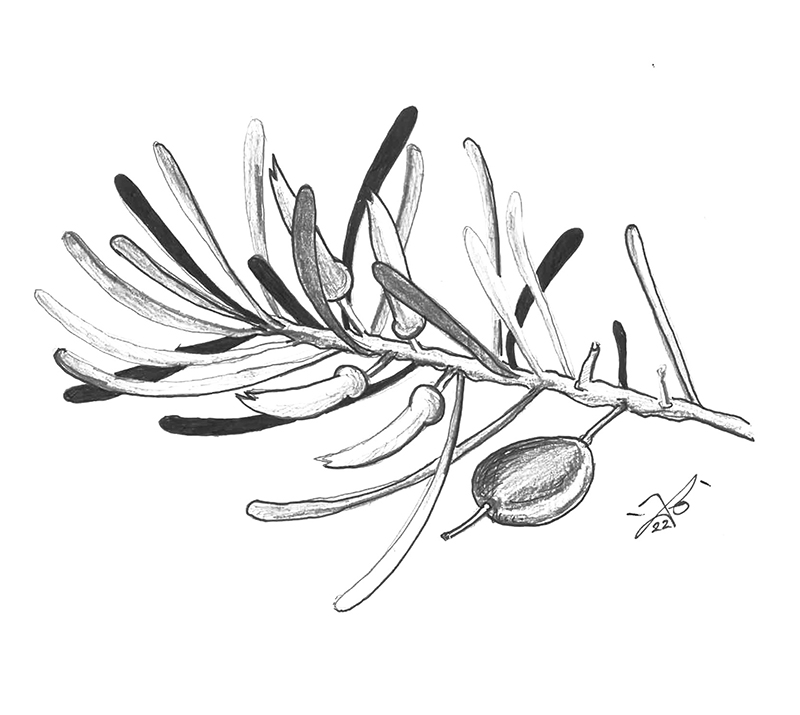
Wongal / Geebung - Illustration by Joel Barney
Endemic to coastal areas and the wallum country of eastern Australia.
Food: When the fruit is ripe, the pulp is sweet and fibrous.
Preserve: When the bark is combined with water, a preserve is created. Twine and nets can be soaked in this mixture to preserve them.
-
Butchulla name: Djaga
Common name: Grasstree
Scientific name: Xanthorrhoea johnsonii

Djaga / Grasstree illustratoin by Joel Barney
Found growing in eastern Australia including K’gari.
Tools: The flower stalk can be used as a light spear for fishing, and when rubbed with hardwood it is used to start fire.
Resin from the trunk is mixed with white ash from the fire to create glue for binding weapons and tools.Weaving: Leaves are woven by women to make baskets.
Food: Flowers provide sweet nectar to eat. Leaf bases and new shoots are also eaten.
Medicine: The flower heads and bark can be thrown
into fire and inhaled to cure cold-like symptoms. -
Butchulla name: Bupu
Common name:K'gari Apple
Scientific name: Acronychia imperforata

Bupu / K'gari Apple illustration by Joel Barney
Found growing in coastal areas of K’gari and New South Wales to northern Queensland.
Food: Nutritious fruit can be eaten raw and has an astringent flavour.
Hunting Habitat: When in flower this plant encourages insects and wildlife like fruit bats to the coastal ecosystem.
-
Common name: Sandfly Bush
Scientific name: Zieria smithii
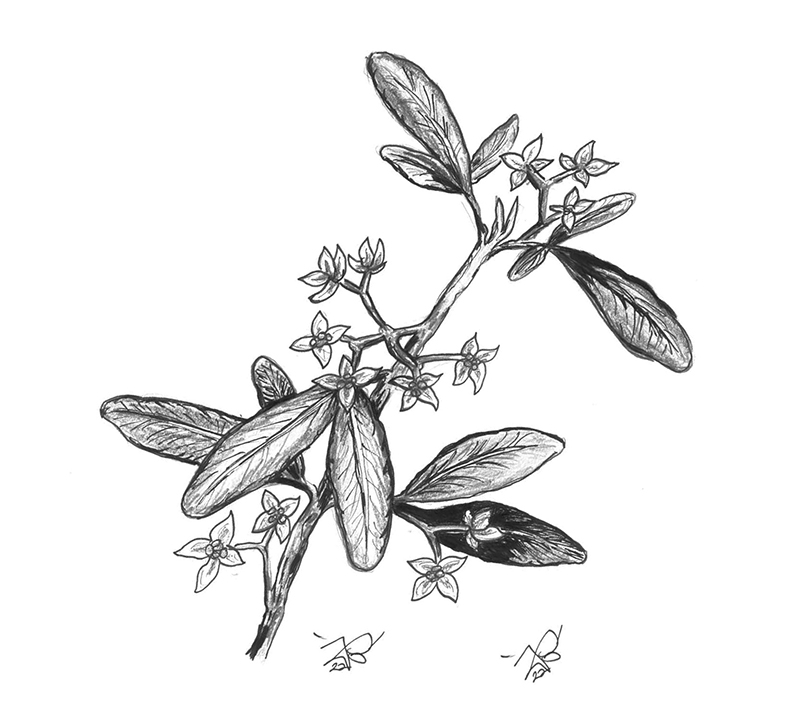
Sandfly Bush illustration by Joel Barney
Endemic to eastern and south-eastern Australia.
Wellbeing: Foliage has insect repellent properties.
Medicine: Used to ease congestion and headaches.
-
Common name: Finger Lime
Scientific name: Citrus australasica
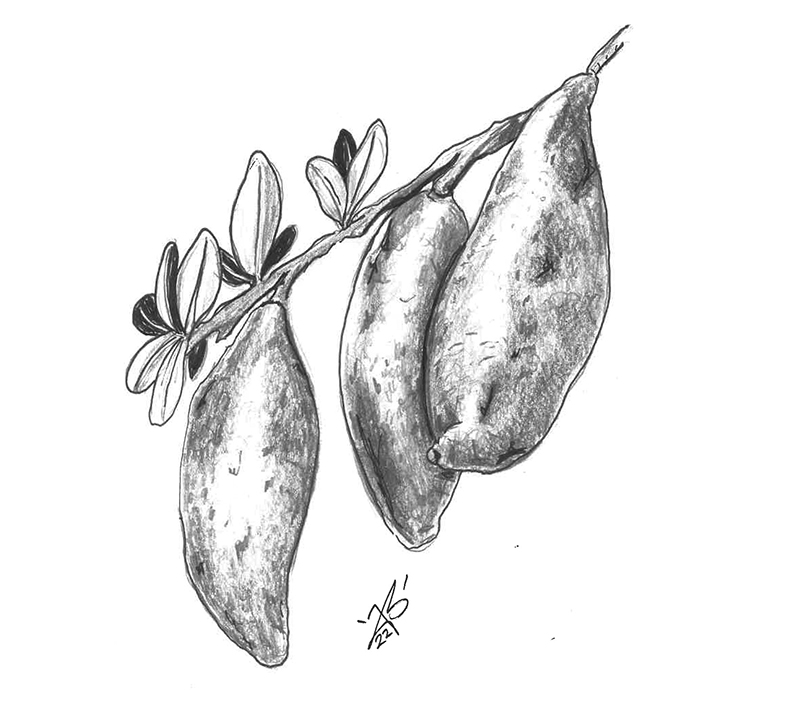
Finger Lime illustration by Joel Barney
Endemic to southeast Queensland and northern New South Wales.
Food: Delicious zesty citrus fruit.
Medicine: The pulp and juice of Finger Limes have known antibacterial properties and can be applied as an antiseptic to wounds and boils.
Wellbeing: Powerful nutrition properties – high in folate, potassium, vitamin E and vitamin C.
-
Common name: Blue Tongue
Scientific name: Melastoma malabathricum subsp.

Blue Tongue illustration by Joel Barney
Scrub country throughout Australia and Asia.
Food: The fruit have sweet fleshy pulp that are edible, with the pulp staining the tongue blue-black after eating.
Young leaves eaten raw or cooked, sour flavour.Medicine: The bark is utilised for treating dysentery and toothache.
The leaves and roots are pounded and applied on wounds to ease swelling.Natural Dye: Seeds are used to produce a black dye, while the roots produce a pink dye.
-
Common name: Black Wattle
Scientific name: Acacia leiocalyx
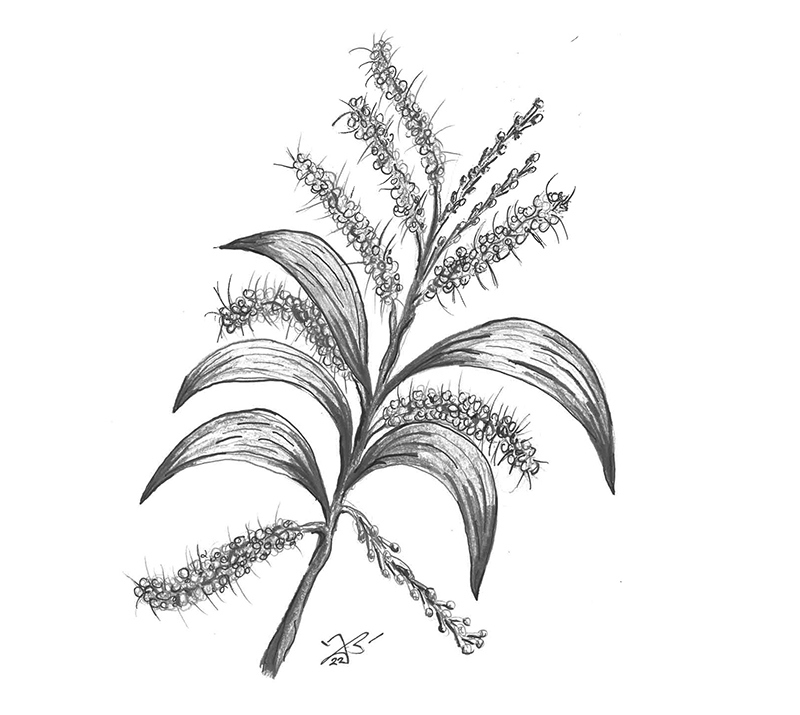
Black Wattle illustration by Joel Barney
Widespread and common in eucalypt woodlands, especially on Wallum country.
Food: Seeds of the Diilgar are collected and eaten raw, roasted or ground into a flour.
Wellbeing: The gum can be sucked as a snack or soaked as a source of fibre.
Tools: The wood can be used to produce spears, boomerangs, spear throwers, clubs, shields, handles for axes and chisels, coolamons and digging sticks.
-
Butchulla name: Dundardum
Common name: Queensland Kauri Pine
Scientific name: Agathis robusta
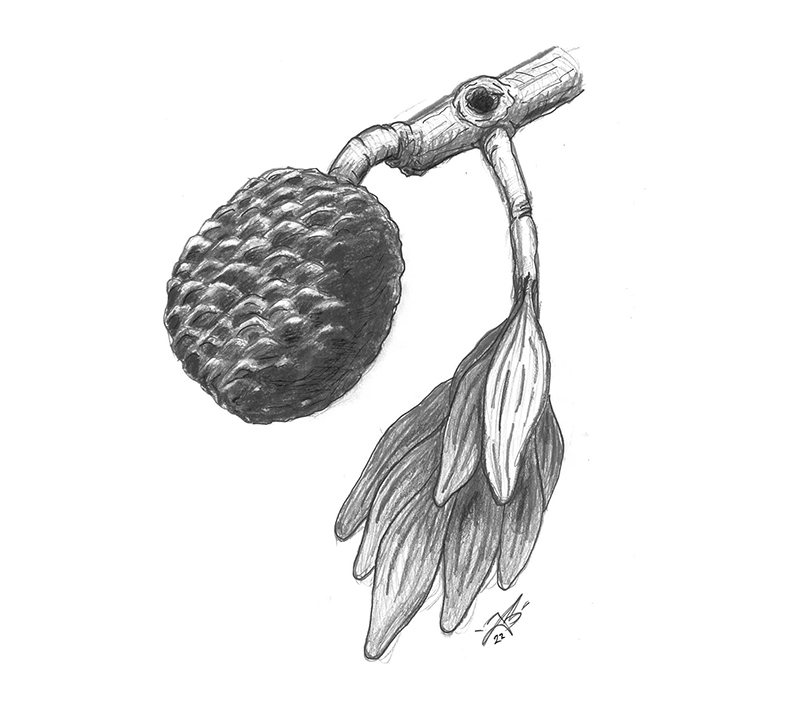
Dundardum / Queensland Kauri Pine illustration by Joel Barney
Found in rainforest areas of the Mary River country and K’gari
Tools: Fishing nets and baskets are made from the inner bark.
-
Butchulla name: Banya
Common name: Bunya Pine
Scientific name: Araucaria bidwillii
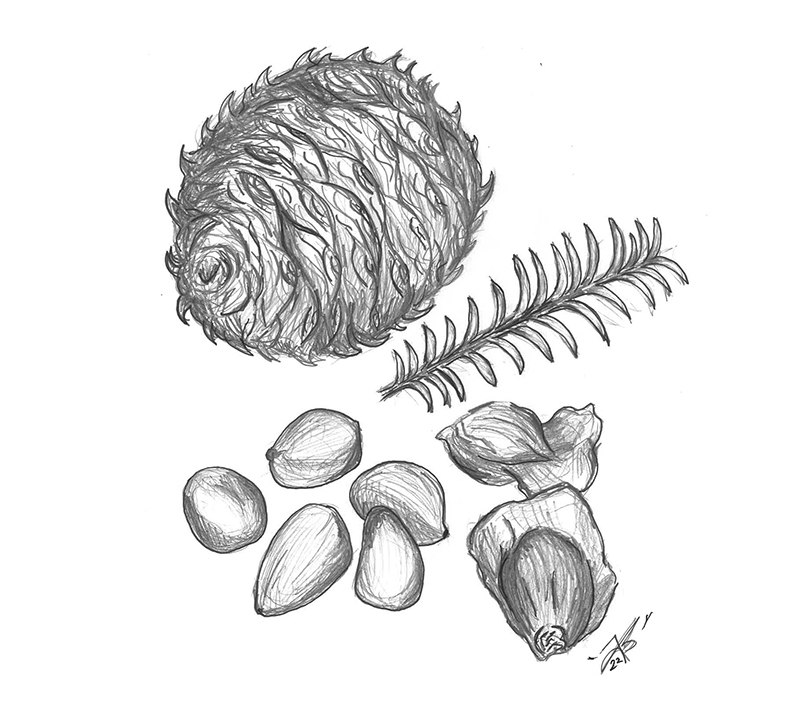
Banya / Bunya Pine illustration by Joel Barney
Endemic to Queensland. Found in some mountainous country throughout south-east and northern Qld.
Ceremony and Feast: Every two or three years, the Bunya Pine produce a particularly prolific crop. During these seasons, the abundance of the seed facilitated massive gatherings where various Aboriginal tribes from many countries would travel to the mountains to enjoy the shared harvest of the nuts.
These large gatherings were used as important opportunity for trade, sharing lore, stories and celebrations.Food: The inner kernel (nut) is eaten raw or roasted in an open fire.
-
Butchulla name: Midgen
Common name: Midyim
Scientific name: Austromyrtus dulcis

Midgen / Midyim illustration by Joel Barney
This small shrub is found naturally growing in sandy soils across heath, scrub, open forest and rainforest margin terrains on Kgari and other coastal areas of NSW and QLD.
Food: The small white, purple-speckled berries are found in profusion throughout late Summer and early Autumn.
The berries are delicious, similar in taste and appearance to the blueberry and are eaten raw. Tea can be made from the leaves. -
Common name: Red Silky Oak
Scientific name: Grevillea banksii
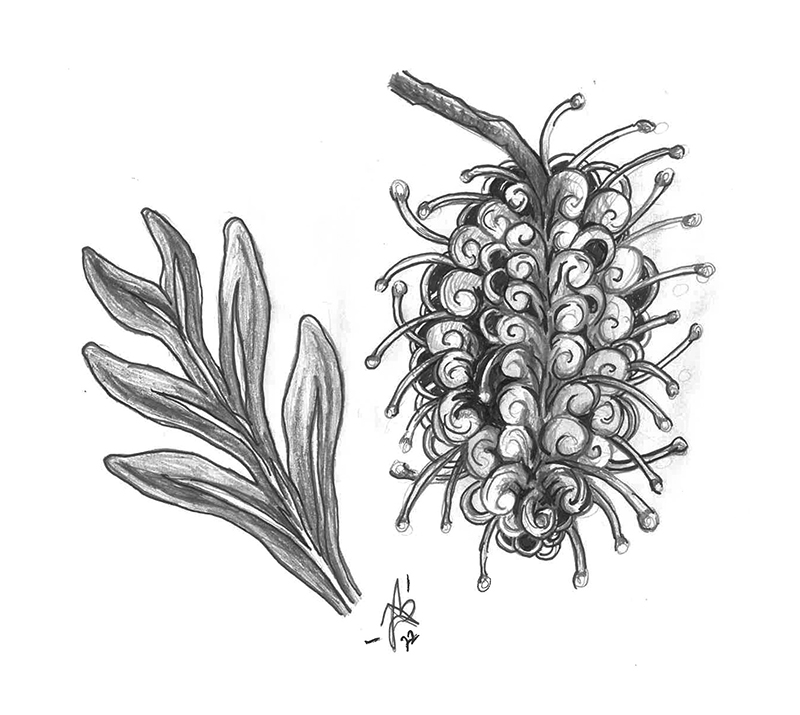
Red Silky Oak illustration by Joel Barney
Found on the Queensland coast from Ipswich to Byfield National Park. Mostly grows
on headlands, ridges and in forest country.Food: The nectar from Grevillea flowers is popular for its sweetness. The nectar is shaken onto the hand or put into a coolamon with a little water to make a sweet drink.
Warning: The flowers and seed pods contain toxic hydrogen cyanide and have caused toxicity and allergic reactions. -
Butchulla name: Deebing
Common name: Paperbark
Scientific name: Melaleuca sp.
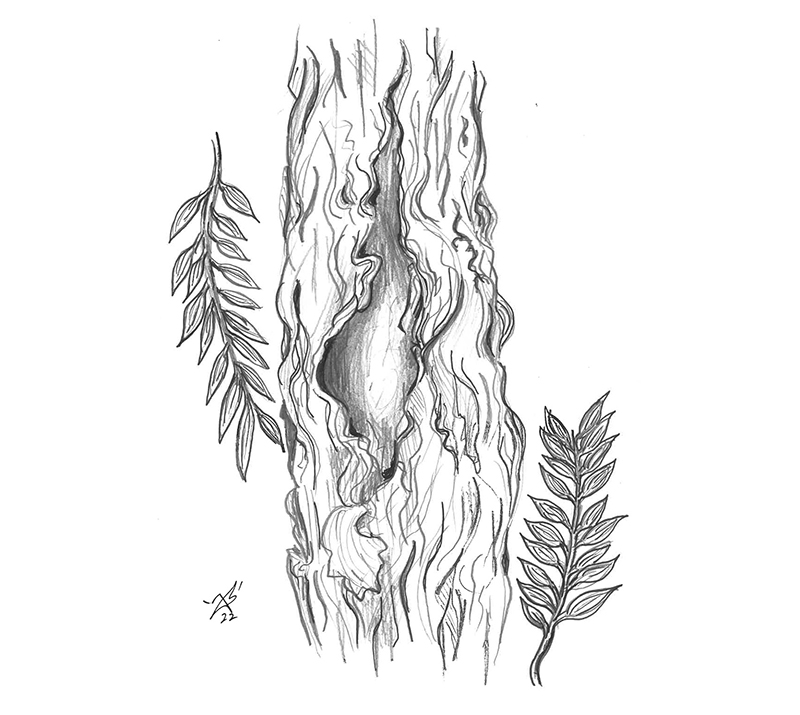
Deebing / Paperbark illustration by Joel Barney
Native to New Caledonia, Papua New Guinea and coastal eastern Australia.
Shelter: Paperbark can be useful as a shelter covering and or bedding because it is soft and repels water.
Food Preparation: Softer pieces of paperbark can be soaked in water and wrapped around food, such as fish, emu or kangaroo and placed on the fire to cook. The soft paper bark is also used to collect and hold birds’ eggs.
Medicine: An essential oil obtained from the fresh leaves and twigs has antiseptic qualities and was used to treat wounds and insect bites.
Wellbeing: A Women’s Business plant the soft bark is peeled away from the trunk in sheets, which can be used during menstruation, during and after childbirth and for physical injury.
Women use the coolamons, which is an indigenous Australian word for bowl, to put their babies in or carry food and water.Ceremony: Women would birth with the baby being born onto a soft sheet of paperbark and it might be used later for the smoking or welcoming ceremony for the infant.
Food: Flowers are used for their nectar to eat and sweeten water.
Hunting Habitat: This tree encourages a diverse range of insects and wildlife like fruit bats to the coastal ecosystem.
-
Common name: Geebung
Scientific name: Persoonia virgata

Queensland Cycas illustration by Joel Barney
A widespread, native cycad in seasonally dry tropical sclerophyll woodlands close to the east coast of Queensland.
Food: The fruit kernels are roasted and ground into a flour after many days of drying, soaking and leaching to remove toxins.
Warning: All plant parts are considered highly toxic. However, after careful and extensive preparation to remove the toxins, the seeds may be safely eaten.
-
Common name: Thyme-leaf Honeymyrtle
Scientific name: Melaleuca thymifolia
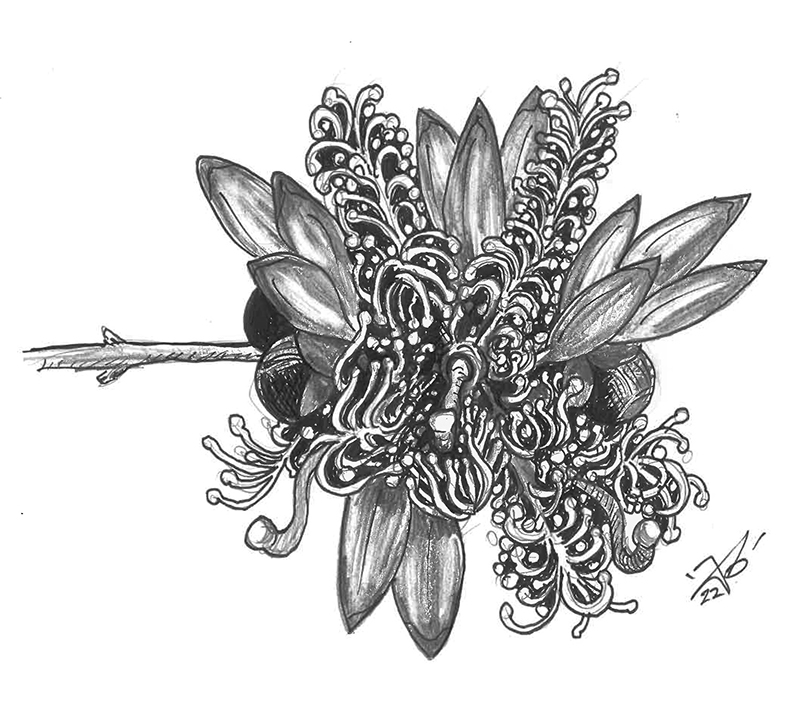
Thyme-leaf Honeymyrtle illustration by Joel Barney
Native to wallum and heathland country throughout the coastal areas of Queensland and New South Wales.
Medicine: An essential oil obtained from the fresh leaves and twigs has antiseptic qualities and can be used to treat wounds and insect bites.
Hunting Habitat: When in flower this plant encourages insect and wildlife diversity to the wallum ecosystem.
-
Butchulla name: Gululai
Common name: Coastal Cypress Pine
Scientific name: Callitris columellaris
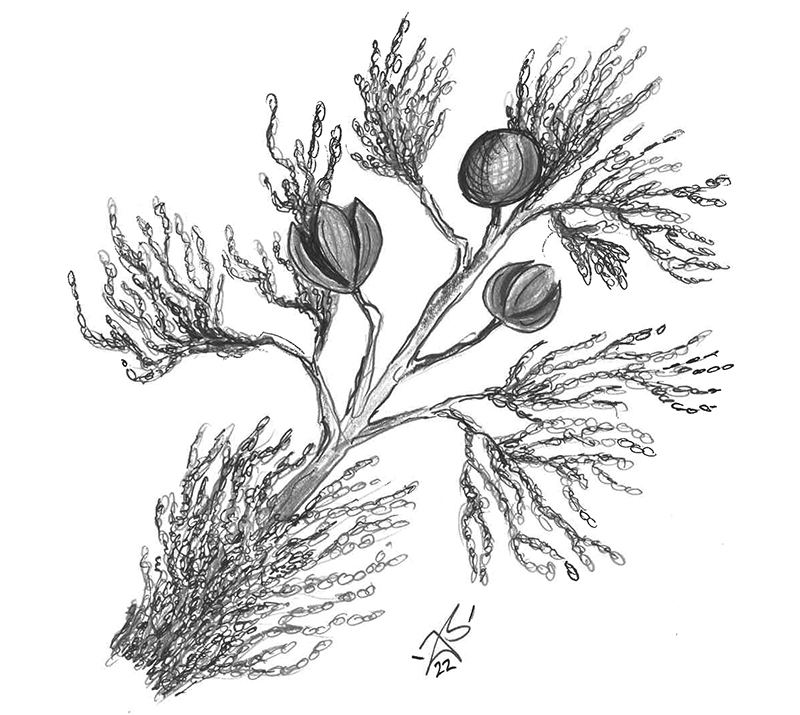
Gululai / Coastal Cypress Pine illustration by Joel Barney
Primarily grows on sandy soils throughout Australia except Tasmania.
Medicine: The leaves can be ground and boiled to make a washing medicine for sores and to relieve abdominal cramps and cold symptoms.
A long strand of inner bark can be wrapped around the abdomen (to relieve abdominal cramps).
Wellbeing: When the bark is thrown into the campfire it repels mosquitoes and midges.
Food: The gum is chewed as a refreshing pine flavoured treat.
-
Common name: Fringe Wattle
Scientific name: Acacia frimbriata
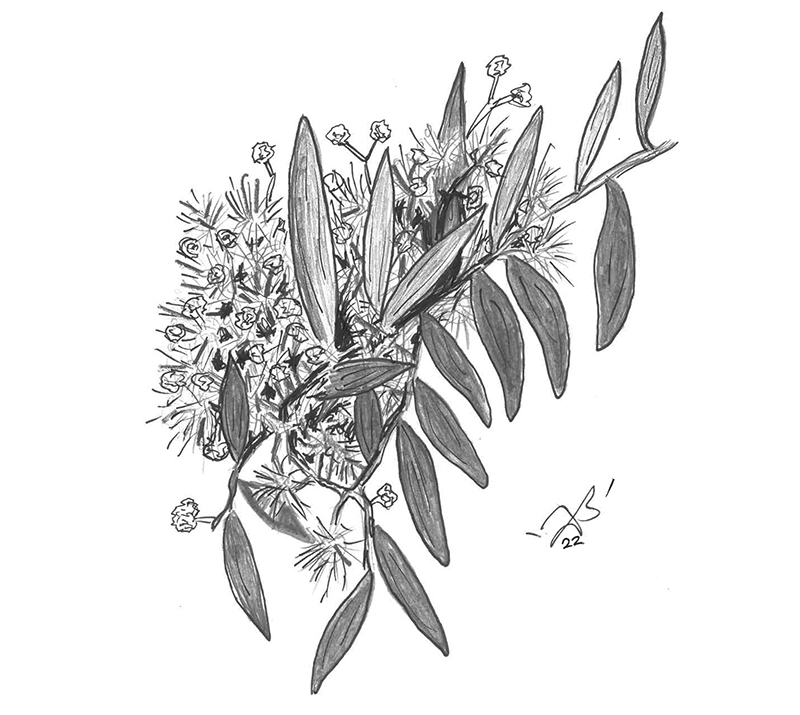
Fringe Wattle illustration by Joel Barney
Favours moist sites near streams and on margins of light rainforest, and on hillsides as an understorey in eucalypt woodland or open forest throughout eastern Australia.
Food: The seeds are edible, nutritious and have a chocolate like taste. The seeds can be harvested and eaten raw or roasted. When the seeds are pounded using strong bark and rocks, they form a gluten-free flour like paste. The Wattle gum was also eaten as a snack.
Tools: The wood can be used to produce spears, boomerangs, spear throwers, clubs, shields, handles for axes and chisels, coolamons and digging sticks.
-
Common name: Mat Rush
Scientific name: Lomandra longifolia
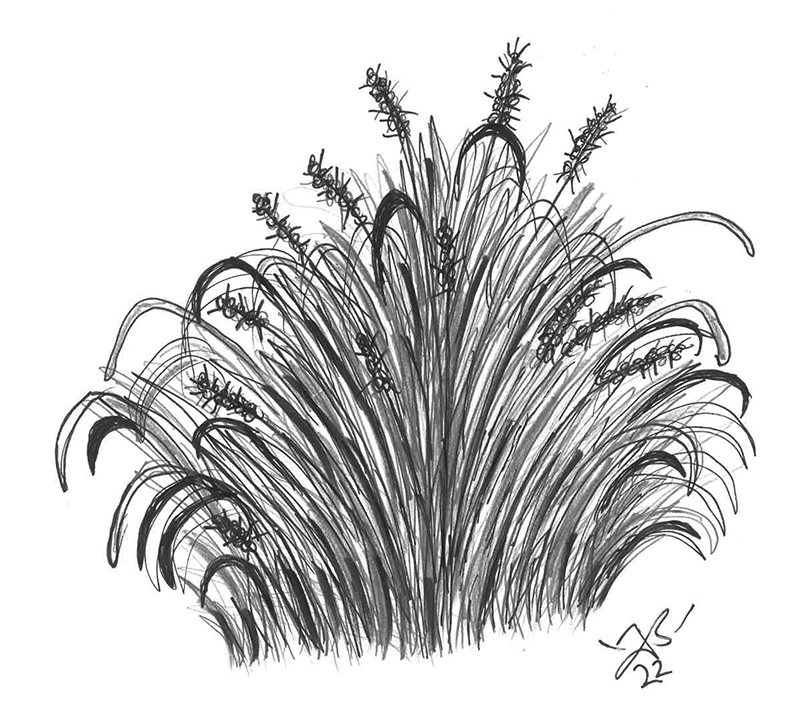
Mat Rush illustration by Joel Barney
Grows naturally in a range of sandy soils, in swamps and wet places to the montane zone on banks of creeks, rocky hillsides, cliffs and open forests throughout most of Australia.
Food: The white starchy bases of the Lomandra can be chewed and supply an energy boost on long walks. The seeds can be pounded and made into flour or eaten whole and mixed with native honey.
Weaving: The strappy leaves are useful to weave baskets and dilly bags for carrying food as well as eel traps and nets.
Medicine: Roots of the Lomandra are also used to relieve insect bites.
-
Common name: Flax Lily
Scientific name: Dianella caerulea
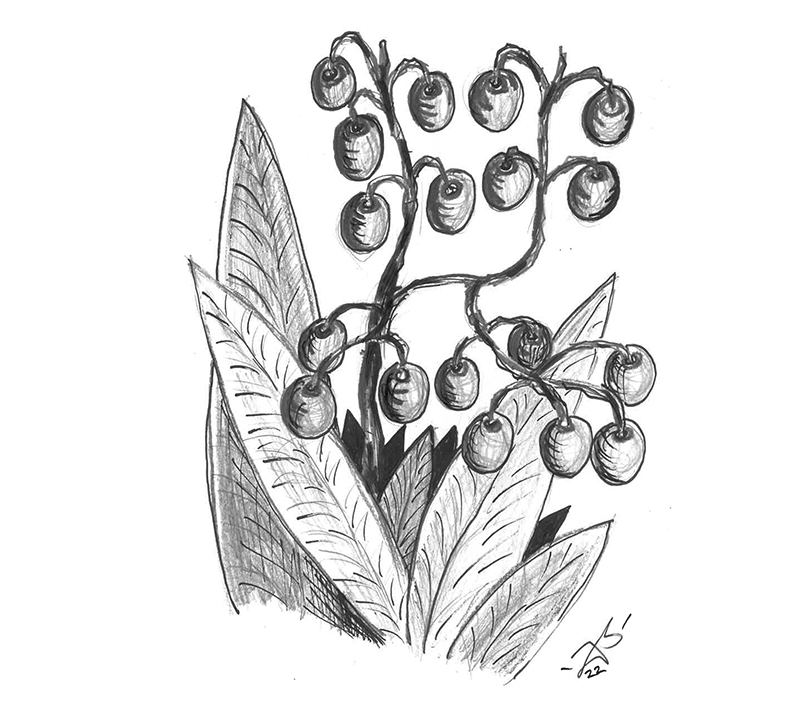
Flax Lily illustration by Joel barney
Found growing naturally across the eastern states of Australia and Tasmania.
Food: The sweet purplish/blue berries and tiny nutty flavoured seeds are eaten raw. The root rhizomes are collected and pounded for roasting in the campfire.
Weaving: The strappy leaves are used for weaving dillybags and nets.
Natural Dye: Berries make a permanent blue dye.
-
Common name: Hairy Pea Bush
Scientific name: Pultenaea villosa

Hairy Pea Bush illustration by Joel Barney
This widespread species can be found in dry, open forests and woodlands from southern Queensland to southern New South Wales.
Hunting ground: This wallum shrub provides habitat for a diverse range of wildlife including birds, insects and small marsupials.
The illustrations for this garden were supported by the Regional Arts Development Fund (RADF), a partnership between the Queensland Government and Fraser Coast Regional Council to support local arts and culture in regional Queensland.